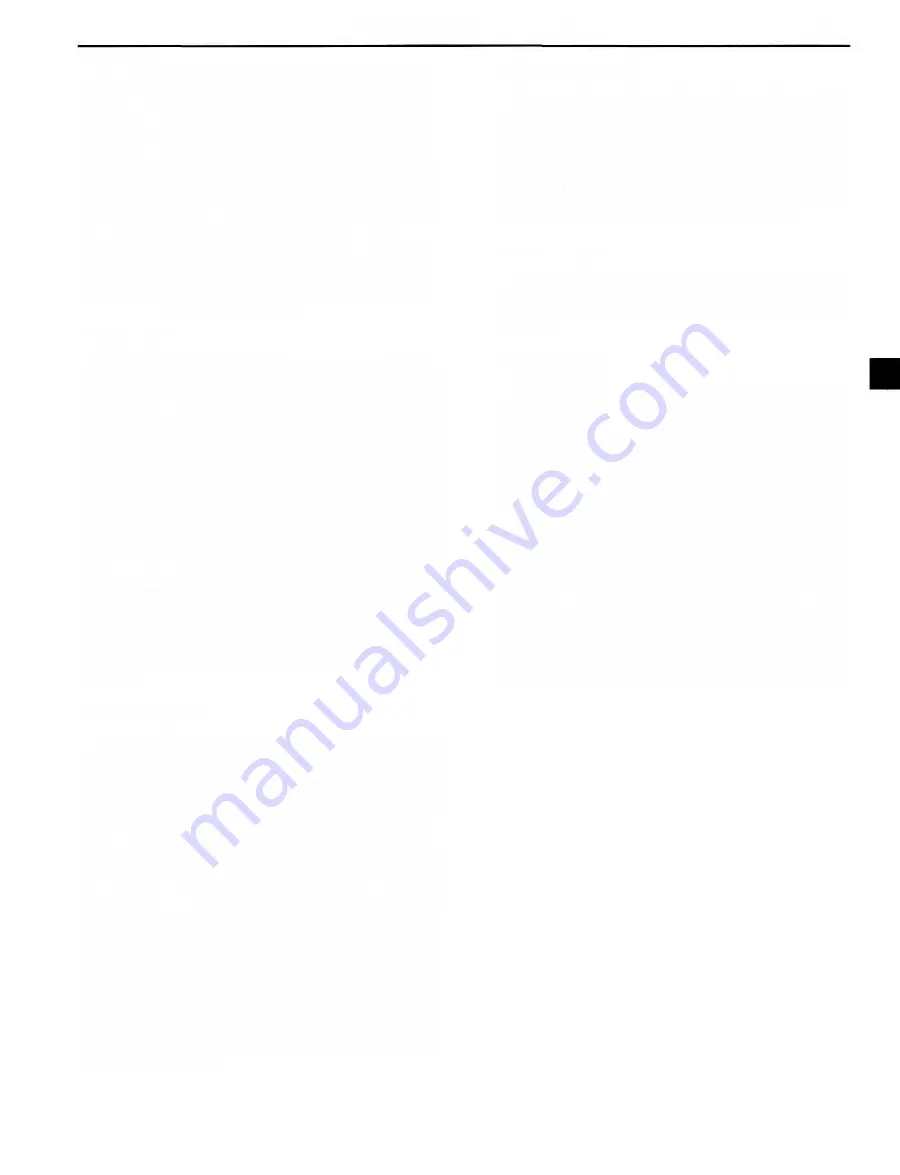
CO-3
COOLING SYSTEM - Description
The cooling system is composed of the water
jacket (inside the cylinder block and cylinder head),
radiator, water pump, thermostat, cooling fan,
hoses and other components. Coolant which is
heated in the water jacket is pumped to the radiator,
where it is cooled by the cooling fan and the vehicle
windstream. Coolant which has been cooled is then
sent back to the engine by the water pump, where
it cools the engine. The water jacket is a network of
channels in the shell of the cylinder block and
cylinder head through which coolant passes. It is
designed to provide adequate cooling of the cylin-
ders and combustion chambers which become the
hottest during engine operation.
RADIATOR
The radiator performs the function of cooling the
coolant which has passed through the water jacket
and become hot, and it is mounted in the front of
the vehicle. The radiator consists of an upper tank
and lower tank, and a core which connects the two
tanks. The upper tank contains an inlet for coolant
from the water jacket and a filler inlet. It also has a
hose through which excess coolant or steam can
flow. The lower tank has an outlet and drain cock
for the coolant. The core contains many tubes and
cooling fins through which coolant flows from the
upper tank to the lower tank so that coolant has
been heated up as it passes through the water
jacket is cooled heae by the air sucked through the
radiator by the cooling fan, as well as by the wind
generated by the vehicle's travel. Models with an
automatic transmission include an automatic trans-
missions fluid cooler built into the lower tank of the
radiator.
RADIATOR CAP
The radiator cap is a pressure type cap which
seals the radiator, resulting in pressurization of the
radiator as the coolant expands. The pressurization
prevents the coolant from boiling even when the
coolant temperature exceeds 100°C (212°F). A
relief valve (pressurization valve) and a vacuum
valve (negative pressure valve) are built into the
radiator cap. When the pressure generated inside
the cooling system exceeds the limit (coolant
temperature: 110-120°C, 230 - 248°F, pressure;
0.3-1.0 kg/cm
2
, 4.3-14.2 psi, 29.4-98.1 kPa)
the relief valve is opened by the pressure and lets
steam escape through the overflow pipe. The vac-
uum valve opens to allow atmospheric air to enter
to alleviated the vacumm which develops in the
cooling system after the engine is stopped and the
coolant temperature drops. The valve's opening
allows the pressure in the cooling system to return
to the reservoir tank.
RESERVOIR TANK
The reservoir tank is used to catch coolant which
overflows the cooling system as a result of volu-
metric expansion when the coolant is heated. When
the coolant temperature drops the coolant in the
reservoir tank returns to the radiator, thus keeping
the radiator full at all times and avoiding needless
coolant loss. To find out if the coolant needs to be
replenished, check the reservoir tank level.
WATER PUMP
The water pump is used for forced circulation of
coolant through the cooling system. It is mounted
on the front of the cylinder block and driven by a
drive belt.
THERMOSTAT
The thermostat has a wax type by-pass valve and
is mounted in the cylinder block. The thermostat
includes a type of automatic valve operated by
fluctuations in the coolant temperature. This valve
closes when the coolant temperature drops, pre-
venting the circulation of coolant through the radi-
ator and thus permitting the engine to warm up
rapidly. The valve opens when the coolant temper-
ature has risen, allowing the circulation of coolant.
Wax inside the thermostat expands when heated
and contracts when cooled. Heating the wax thus
generates pressure which overpowers the force of
the spring which keeps the valve closed, thus
opening the valve. When the wax cools, its con-
traction causes the force of the spring to take effect
once more, closing the valve. The thermostat in this
engine operates at a temperature of 76°C (169°F).
Summary of Contents for 1HD-T
Page 1: ......
Page 53: ...EM 42 ENGINE MECHANICAL Timing Gears TIMING GEARS COMPONENTS ...
Page 65: ...EM 54 ENGINE MECHANICAL Cylinder Head CYLINDER HEAD COMPONENTS ...
Page 95: ...EM 84 ENGINE MECHANICAL Cylinder Block CYLINDER BLOCK COMPONENTS ...
Page 133: ...TURBOCHARGER SYSTEM Turbocharger TC 9 COMPONENTS ...
Page 145: ...FU 6 FUEL SYSTEM Fuel Heater System FUEL HEATER SYSTEM SYSTEM CIRCUIT ...
Page 166: ...FUEL SYSTEM Injection Pump FU 27 INJECTION PUMP REMOVAL OF INJECTION PUMP ...
Page 169: ...FU 30 FUEL SYSTEM Injection Pump COMPONENTS ...
Page 170: ...FUEL SYSTEM Injection Pump FU 31 COMPONENTS Cont d ...
Page 171: ...FU 32 FUEL SYSTEM Injection Pump COMPONENTS Cont d ...
Page 251: ...LU 4 LUBRICATION SYSTEM Troubleshooting TROUBLESHOOTING ...
Page 255: ...LU 8 LUBRICATION SYSTEM Oil Pump OIL PUMP COMPONENT ...
Page 272: ...ST 4 STARTING SYSTEM Pre Heating System Super Glow Type TIMER CHARACTERISTIC DIAGRAM Cont d ...
Page 282: ...ST 14 STARTING SYSTEM Starting System Circuit STARTING SYSTEM CIRCUIT Cont d ...
Page 340: ...B 1 STANDARD BOLT TORQUE SPECIFICATIONS Page STANDARD BOLT TORQUE SPECIFICATIONS B 2 ...
Page 343: ...C 1 SSTAND SSM Page SST SPECIAL SERVICE TOOLS C 2 SSM SPECIAL SERVICE MATERIALS C 6 ...
















































